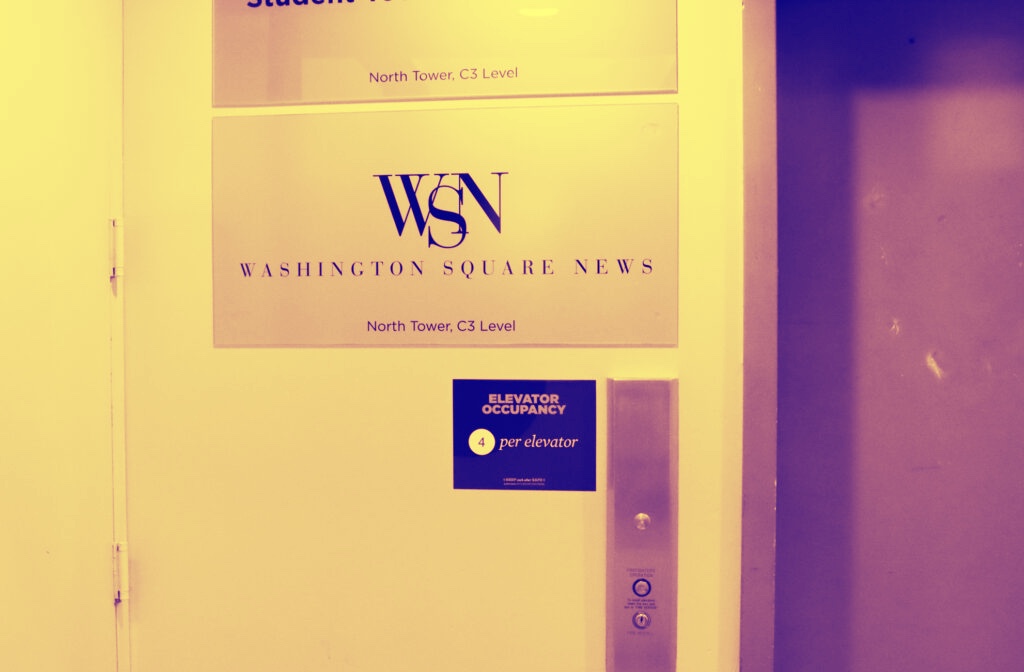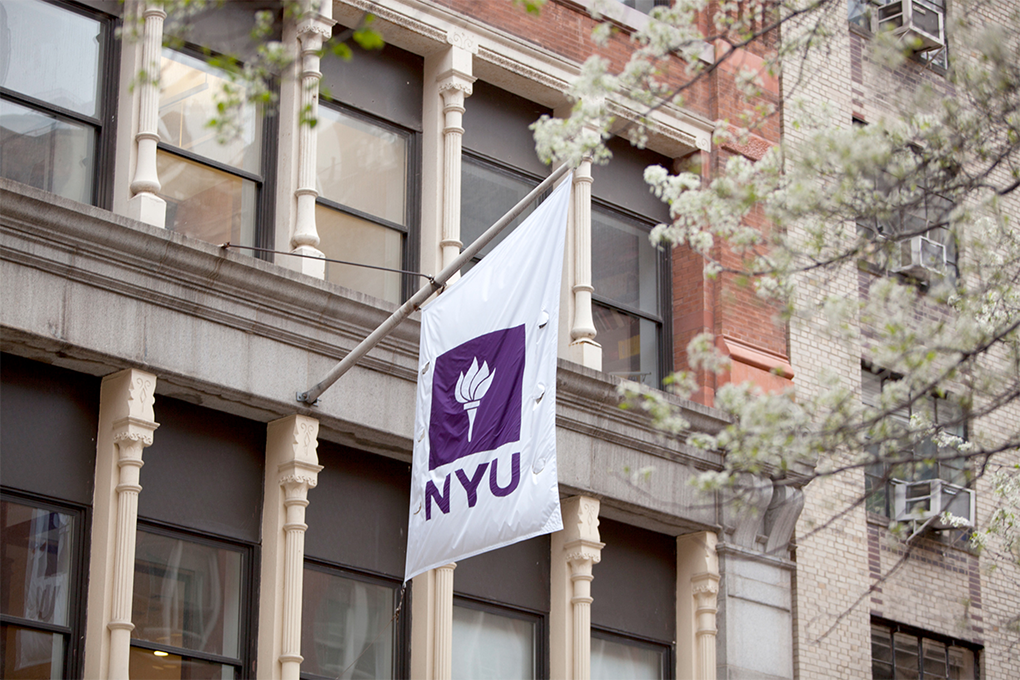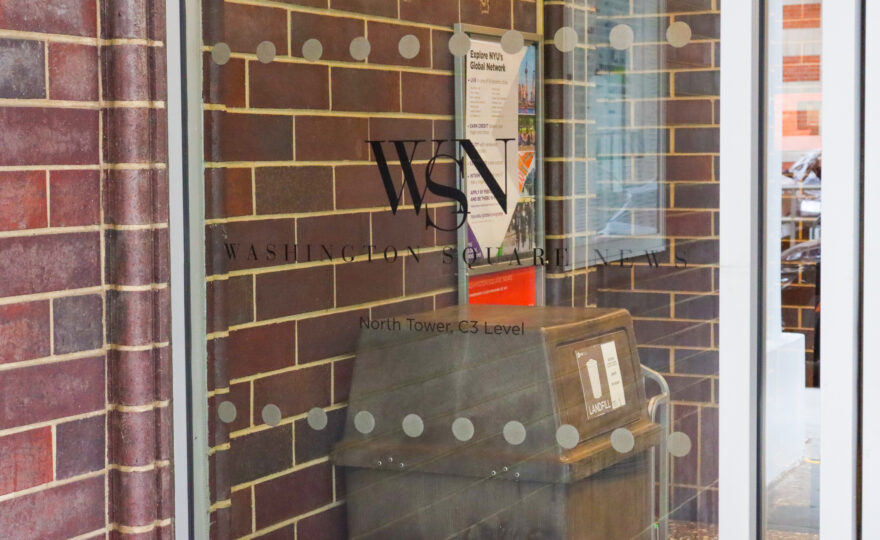The lobby elevator to the currently defunct Washington Square News newsroom [Credit: Sarah Parker]
(NEW YORK) — The September mass walkout from Washington Square News (WSN), in which 43 out of 47 staffers at New York University’s newspaper resigned because of conflicts with their new media adviser, has left the school’s community with no student-run newspaper for more than a month, an absence readers register as a loss.
“Right now, we’re just facing a time in which it is really difficult to be a community,” said Diego Quintana Licona, a junior who also represents LGBTQ+ and low-income, Latinx students as a senator at-large for NYU’s Student Senators Council (SCC). “The administration and student body’s ability to communicate is very spread out…WSN was a link for many students’ stories. Where is that point of connection now?” Quintana Licona and other NYU students who talked to The Click for this story have been contributors or interview subjects for WSN in the past.
The Click also spoke with media experts who echoed Quintana Licona’s sentiment. They said that college publications—particularly ones like WSN, which are fully student-run and independent of a school—are vital for members of a community to stay informed. “It can be devastating to a community to lose a trusted local source of news, especially if the loss happens abruptly,” said Stefanie Murray, director of the Center for Cooperative Media at Montclair State University in New Jersey. The Center’s mission is to strengthen local journalism in the state and beyond. “People need access to basic information to live their daily lives, and journalists are first responders in times of crisis.”
Before the pandemic, WSN published one print issue weekly and provided digital content on the weekdays. The newspaper was distributed to over 100 Manhattan locations with a reach of approximately 60,000 students, faculty, staff, and residents in the NYU community. The last article on the WSN website was posted on Sept. 30.
“Honestly, it’s immeasurable how much students have lost in the month or so since WSN stopped updating,” said Paul Ibuzor, NYU school senator for the College of Arts and Sciences. “In our student council group chat that we have, people will put in a tweet, right? Is this tweet real, is it fake? And we don’t know. But when you can’t cite WSN, you can only say Twitter, or you can only say, official university releases—it’s not the same. It makes it very difficult to prove your point.”
The use of Twitter as a source has “a lot of downsides to it because there is so much misinformation, stuff that is completely untrue, the perpetuation of rumors,” he said. One current rumor circulating on Twitter is that NYU has canceled spring break, which is untrue, Ibuzor said, noting that the university senate has yet to make a decision on the matter.
“A campus is a microcosm of a larger community,” said Joe Amditis, associate director of the Center for Cooperative Media at Montclair State University. “Studies show that when a community loses their local newspaper or news provider, things do not get better when people do not have access to information. It’s an integral part of a community.”
A campus presence
WSN has covered several major stories important to the NYU community. Its reporters wrote about the school’s initial handling of the coronavirus, alleged discrimination against low-income students this summer, and the increased presence of New York police officers on campus earlier this fall.
The presence of WSN reporters at student government meetings was important to Christopher Van Demark, an SGA senator for NYU’s Graduate School of Arts and Sciences. Van Demark spoke with The Click from London, where he is conducting research for his Ph.D.
Honestly, it’s immeasurable how much students have lost in the month or so since WSN stopped updating
“WSN would grab me after a meeting to discuss a resolution that I’m working on,” he said. “It’s a way to get whatever I’m working on out there and get feedback; their reach is so large. A resolution that my president and I are working on now is to give more support to students with families, which is a particularly big issue right now with the pandemic. I think that that loss of WSN is going to be most felt when we’re presenting that resolution.”
For those in niche or marginalized groups within the NYU community, WSN’s coverage offered visibility. Third-year student Jordan Newton-House, who is majoring in global liberal studies, was touched when WSN reached out in September for a story about where GLS students were spending their junior years. Before the pandemic led to international border restrictions, NYU’s GLS students spent their junior years abroad, collecting material for their senior year theses.
“It was the first time that somebody outside of liberal studies had ever acknowledged global liberal studies,” Newton-House said.
For some students at NYU, acknowledgment can mean more than inclusion — it can be the first step to creating policies that protect them. “There’s a need for victims of sexual assault, there’s a need for students who are facing food insecurity, who are facing housing insecurity. These are realities that sometimes are not known about, or are not properly showcased,” said Quintana Licona. “And that’s, for me, what WSN was.”
The pandemic, a historic election, remote classes, and on-campus, coronavirus testing are among the pressing student issues that WSN has not covered since the walkout. “At a time when people are making up their mind and dealing with life-and-death public health issues, they really need that information lifeline more than ever,” said Frank LoMonte, director of the Brechner Center for Freedom of Information at the University of Florida. “[The New York Times] is great as the paper of record for international affairs, but they don’t have reporters pounding the beat on your campus.”
Waiting for a resolution
WSN stopped the presses barely a month into the fall academic semester over a dispute with the paper’s media adviser. The newspaper staff who walked out published on WSN’s site a list of allegations against the adviser, Dr. Kenna Griffin, saying that she engaged in “transphobic rhetoric and behavior” and “displayed an increasing disrespect to WSN’s Black staff members.”
Both the WSN management team and staff who resigned have held firm that they would not return until Griffin, a journalism professor based in Oklahoma who is also the current president of the College Media Association (CMA), has been removed as an adviser. WSN students, NYU journalism faculty, and Griffin have not responded to multiple requests for comment from The Click.
On October 16, CMA announced they had decided to dissolve further investigation on Griffin, citing litigation concerns and their assertion that Griffin is still “employed by NYU.” University spokesperson John Beckman, has said that Griffin is not employed by the school. Neither CMA nor NYU have responded to requests for comment on Griffin’s official employment status or updates on further negotiations and investigations.
Despite being editorially independent as described on its website, WSN benefits from a relationship with NYU in the form of free office space and “funding revenue shortfalls.” The Center for Student Life website lists WSN under clubs and organizations as an independent student newspaper. NYU spokesperson Beckman’s statement says the same. Beckman and David Vogelsang at the Center for Student Life have not responded to The Click’s repeated requests for clarity on WSN’s connection to and funding from Student Life.
Until Sept. 30, WSN, which was founded in 1973, was the only campus newspaper at NYU — but it wasn’t the only media organization. There’s also the blog NYU Local, which sometimes partners with radio station WNYU.
The radio station, which has been around in some form since 1949, largely broadcasts alternative and educational music content, though it also covers news. Kelly Drake, the station’s program director, said that they changed their programming to include more news after the pandemic shut down the school’s campus.
In their Sept. 28 statement, WSN recommended that readers obtain their news from NYU Local, which was founded in 2008 and is not affiliated with the university. According to NYU Local staff reporter Alejandra Arevalo, a number of WSN reporters who left the paper are now writing for NYU Local.
It is not clear when—or if —WSN will begin publishing again.
“It’s hard to think of a worse time in American history for a newspaper to be shut down,” said LoMonte. “There’s so much news breaking every single day. The community is just not well-served for a prolonged outage. It’s a huge civic loss when a newsroom goes dark.”
This article was written by The Click reporters Lilian Manansala and Theresa Boersma


